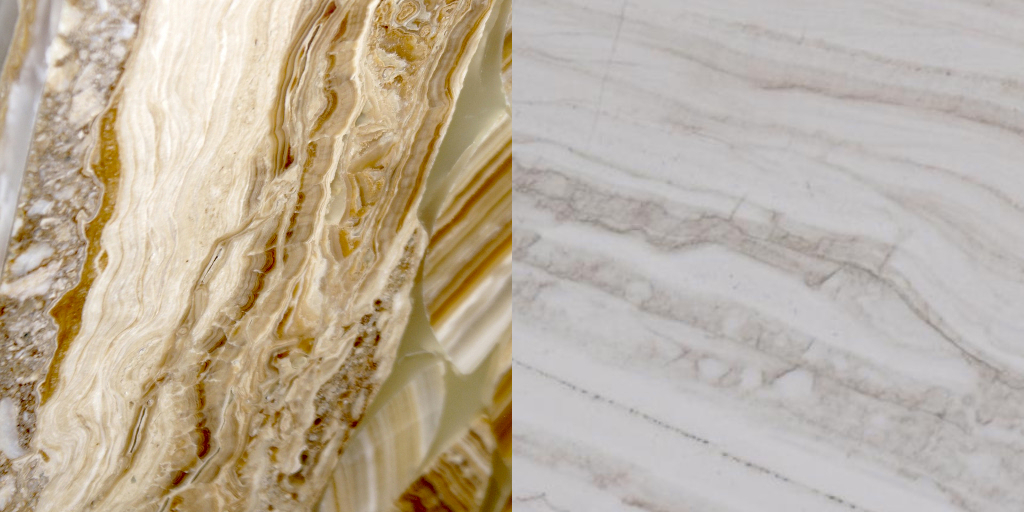Comparing Onyx vs Quartzite
Two extraordinary materials used for countertop surfaces. Each one with distinct traits that make it an amazing stone. Considering onyx vs quartzite leads to some significant differences. But it also reveals some similarities too. And although the differences outnumber the similarities these materials have a lot to offer in the way of design value in you fabrication jobs. So without further ado let’s get into comparing onyx vs quartzite.

An Onyx Overview
Perhaps the best place to start when it comes to considering onyx stone surfaces is its description as published on Use Natural Stone. In that article, the writer (a geologist) begins with the following explanation of what onyx is:
In the commercial stone industry, onyx refers a category of stones that are made of layered bands of light-colored or translucent minerals. Most slabs of onyx are what a geologist would call banded calcite. This same material also goes by the names onyx marble, Mexican onyx, or Egyptian alabaster.
This is the kind of onyx we will discuss here. Onyx is a natural stone that resembles other types of natural stone in its composition. It is made up largely of calcite (or calcium carbonate) and therefore qualifies as a calcareous stone. This class of rock includes very familiar stone such as:
- Marble
- Limestone
- Travertine
Now that we have established what onyx is, let’s consider some of its properties.
Properties of Onyx
Onyx is a natural stone with properties that are good to be familiar with because it allows the material to be used in interesting ways. First, onyx is a relatively soft stone as far as rock is concerned. It registers at around 3 or 4 on the Mohs scale. This means that onyx is fairly easy to shape and even sculpt. Another trait that is found in onyx stone is that it is porous. This makes it absorbent. We will come back to this in a bit. Additionally, onyx has a very distinct appearance that makes it stunning! As mentioned previously, it is calcite but it has bands of color in it. These colored bands are translucent so light can actually pass through these areas of the stone. Making for amazing backlit surfaces and even complete fixtures.
Overview of Quartzite
Along the same lines as onyx, natural quartzite is also an impressive material. And just as onyx goes by a name that has been defined by the commercial stone industry, so too commercial quartzite will be a bit different from the quartzite a geologist will describe. This is imperative for selecting a stone because natural quartzite that a geologist would describe is very hard and has no calcareous material in it. Yet, you will find commercial quartzite to have some calcite in it depending on the stone. So let’s look at the properties of quartzite.
Quartzite’s Properties
To start off, quartzite is composed entirely of quartz. Hence, the name quartzite. It comes in at around 6 or 7 on the Mohs scale and is relatively hard compared to other stone. In contrast to onyx, quartzite is harder to shape and cut. For example, quartzite must be cut using diamond blades for cutting quartzite and other hard material. And although quartzite is not translucent, it does often times have appealing banding that race across its surface and through the material. As far as porosity is concerned, quartzite is less porous than onyx as a general rule, but it is a natural stone and as such, it does need to be sealed using a sealer designed for quartzite.
Comparing Onyx and Quartzite
In a direct comparison, the two stones we are considering would show differences in a few basic areas and some similarities as well. These characteristics would impact how you might see these materials used. Let’s look at some basic traits and see how these properties relate to usage.
Hardness and Scratch Resistance
As we alluded to earlier, hardness plays a role in the scratch resistance of a stone. The harder a stone is, the easier it is to scratch. This may sound like a negative on the surface but it is all in how you view it. Quartzite is significantly harder than onyx so it will be more scratch resistant. But onyx, being softer, is easier to shape and sculpt than quartzite is. And although the hardness is very different, both of these materials are used for countertop surfaces.
Porosity and Stains
To put it simply, both of these stones are porous. Each of them needs to be periodically sealed to help them resist water and oil based stains. Natural stone sealer is available in various forms. One type is impregnating stone sealer that works to keep water and oil on the surface so the stone does not absorb them. Since each individual stone has a unique porosity, water testing is the best way to determine the needs of each particular stone; whether it is quartzite or onyx.
Color Availability
Both commercial quartzite and commercial onyx form in a variety of colors. Here is a table listing the colors each type of stone forms in:
| Onyx vs Quartzite | ||||
|---|---|---|---|---|
| Criterion | Onyx | Quartzite | Similar | Different |
| Hardness | 6-7 | 3-4 |  |
 |
| Porous |  |
 |
 |
 |
| Several Colors |  |
 |
 |
 |
| Commercial/Geological Name Differences |  |
 |
 |
 |

Pingback:Is Onyx a Hard Stone or Soft? | Is Onyx Soft or Hard?